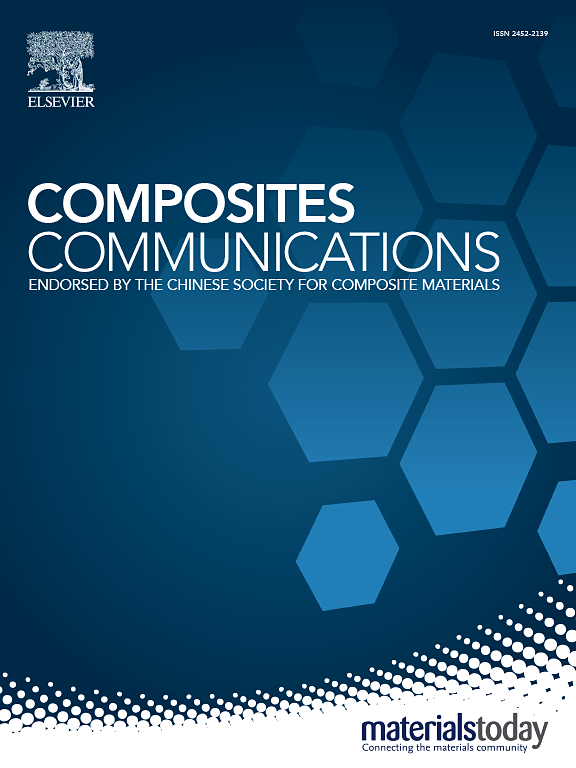Multilayered foam-based electromagnetic interference absorber mimicking free space between pyramid structures
IF 7.7
2区 材料科学
Q1 MATERIALS SCIENCE, COMPOSITES
引用次数: 0
Abstract
In this study, we propose a multilayered foam-based electromagnetic interference (EMI) absorber that mimics the gradient of free-space structure found between conventional pyramid-shaped absorbers. To achieve this, conductive foams with different open cell sizes and multi-wall carbon nanotubes (MWCNTs) concentrations were sequentially stacked to form a composite structure, and a highly reflective conductive film was introduced at the bottom. This design strategy enables gradual impedance matching from the surface and promotes multiple internal reflections within the foam structure, thereby significantly enhancing the absorption of incident electromagnetic waves at the X-band frequency range (8.2–12.4 GHz). We systematically investigated the influence of foam thickness, MWCNTs concentration, cell size, and their stacking order on the total shielding effectiveness (EMI SE), as well as on its absorption and reflection components. While EMI SE was relatively unaffected by stacking sequence, the energy dissipation pathways could be precisely tuned, favoring either absorption or reflection. Notably, the structure with a gradient from large to small cell sizes, combined with a conductive film, achieved over 40 dB of EMI SE at 12.4 GHz, primarily driven by absorption. The results demonstrated that spatial control of foam cell structure and integration of reflective layers provide an effective route for high-performance, absorption-dominant EMI shielding. This approach offers a scalable, lightweight solution for next-generation EMI management in electronics and communication systems.
多层泡沫基电磁干扰吸收器,模拟金字塔结构之间的自由空间
在这项研究中,我们提出了一种多层泡沫基电磁干扰(EMI)吸收器,它模仿了传统金字塔形吸收器之间的自由空间结构梯度。为了实现这一目标,将不同开孔尺寸和多壁碳纳米管(MWCNTs)浓度的导电泡沫依次堆叠形成复合结构,并在底部引入高反射导电膜。这种设计策略可以从表面逐渐匹配阻抗,并促进泡沫结构内部的多次反射,从而显著增强对入射电磁波在x波段频率范围(8.2-12.4 GHz)的吸收。我们系统地研究了泡沫厚度、MWCNTs浓度、细胞尺寸及其堆叠顺序对总屏蔽效能(EMI SE)及其吸收和反射成分的影响。虽然EMI SE相对不受堆叠顺序的影响,但能量耗散路径可以精确调谐,有利于吸收或反射。值得注意的是,该结构具有从大到小的梯度单元尺寸,结合导电膜,在12.4 GHz下实现了超过40 dB的EMI SE,主要是由吸收驱动的。结果表明,泡沫细胞结构的空间控制和反射层的集成为高性能、吸收主导型电磁干扰屏蔽提供了有效途径。这种方法为电子和通信系统中的下一代EMI管理提供了可扩展的轻量级解决方案。
本文章由计算机程序翻译,如有差异,请以英文原文为准。
求助全文
约1分钟内获得全文
求助全文
来源期刊

Composites Communications
Materials Science-Ceramics and Composites
CiteScore
12.10
自引率
10.00%
发文量
340
审稿时长
36 days
期刊介绍:
Composites Communications (Compos. Commun.) is a peer-reviewed journal publishing short communications and letters on the latest advances in composites science and technology. With a rapid review and publication process, its goal is to disseminate new knowledge promptly within the composites community. The journal welcomes manuscripts presenting creative concepts and new findings in design, state-of-the-art approaches in processing, synthesis, characterization, and mechanics modeling. In addition to traditional fiber-/particulate-reinforced engineering composites, it encourages submissions on composites with exceptional physical, mechanical, and fracture properties, as well as those with unique functions and significant application potential. This includes biomimetic and bio-inspired composites for biomedical applications, functional nano-composites for thermal management and energy applications, and composites designed for extreme service environments.
 求助内容:
求助内容: 应助结果提醒方式:
应助结果提醒方式:


